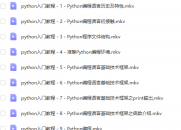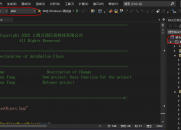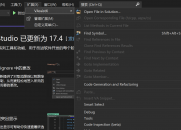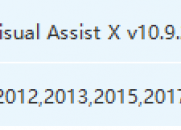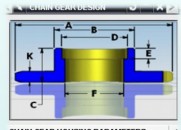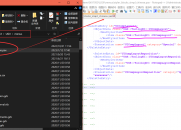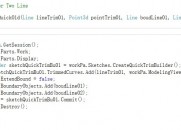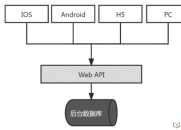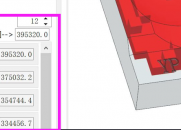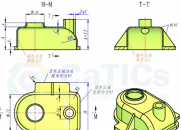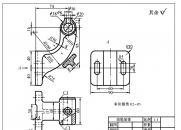|
|
请使用QQ关联注册PLM之家,学习更多关于内容,更多精彩原创视频供你学习!
您需要 登录 才可以下载或查看,没有账号?注册

x
9 H5 x# O- }1 k, ]3 d: i" Z2 o) h
8 P( l3 F( ]% o5 [0 }0 P7 {( s& |$ UNX二次开发源码分享: 获取当前Reference Component的通用方法* l! J9 @' c) _. W5 g5 y2 q% r
; T& w5 G3 U5 x& i0 Y" f
. C2 T7 ^3 N8 ~+ G1 Z: T
* G. o K5 f5 [1 K4 C
! r: ?4 c- _% k1 Y$ Y9 ?3 d1 w: G& w3 Q& |; f$ A4 \' A& I
[mw_shl_code=c,true]static logical attribute_exists(Component cmpnt, char *title)
; s3 [) O/ t" L6 f{8 c. v$ [4 K: E8 A% E
; E0 i2 [* }8 K; t, S// The traditional method of asking for all of the components recursively// does not work if you are looking for reference-only components,// because they are not retured when you ask for the children.//// Also, asking for the AssembliesGeneralPropertiesBuilder.ReferenceComponent // Property does not work in versions earlier than NX12.//// The workaround is to cycle for components the old-fashioned way,// and then ask whether each one has the REFERENCE_COMPONENT attribute.//// If you have multiple occurrences of a given component in the assembly,// each one will be reported.
8 ~+ u+ ^" m9 B
/ G' }) k; Q/ }7 }3 y1 H logical
& O: e+ o3 l! x0 p" \! p% p+ ~/ L% S hasRefAttr = FALSE;0 d1 m: a8 H1 ^4 f- @3 g4 h
; T$ I7 O0 v+ ^) @8 V
hasRefAttr = cmpnt.HasUserAttribute(RO, NXObject::AttributeTypeAny, -1);
+ W" {: E- P5 F+ S- R6 A
9 M6 X- J' M% u if(hasRefAttr == TRUE)
$ M2 _9 x4 S4 E1 B {
, z/ z8 T6 u0 T0 S( ^( f* q return TRUE;
# z% y0 v$ ~) S) K8 S* i }
& @* r) h$ e, e; r2 \
9 N" ~- d9 O8 R! r; z/ V; t8 [ return FALSE;* M2 p- B; V+ `' q& T% v- R
3 [, Q* S; R9 ~
}& d- w8 b I: v: a8 Q9 h
* B- r( K- g5 j% x
static tag_t ask_next_of_type(tag_t part, int type, tag_t object)' i& g$ O. @. Q' a' n- C
{1 B- j: ^/ T+ u: H9 R
UF_CALL(UF_OBJ_cycle_objs_in_part(part, type, &object));
! M7 s) r5 U7 t3 ?% Q return (object);
" f1 v' ]9 x. t8 h}2 v4 E/ K1 Q0 U: c
" a" {8 ~5 N5 p) h# ustatic void do_it(void)$ n& r9 t9 n( U0 _: T' d7 l2 P
{
4 _1 q( [# ?; y1 O+ t5 ~ // Assumes that the display part is the top of the assembly% a% d( n8 w7 G5 D
0 S6 r, T) w2 [1 K1 f4 F
tag_t
1 w7 m3 b: x3 s) |' _% S& `& M/ y dispPart = UF_PART_ask_display_part();
( F E9 T9 F9 v& X* G+ u
- @5 x4 a# [6 B* r9 S% ~0 J if(NULL_TAG == dispPart)
8 I2 d- Z" g1 w3 l* S {( ~' T3 E9 |+ o' i K' r# T
ECHO("Program requires an active displayed part");
# J8 x- s" U! q2 o; n2 ~! H return;
8 N# J, k+ v. ^! O }
) x% v* |3 h* n2 _
) G8 q: t& H: `$ j tag_t @! J! \0 N. y2 d" ~9 X
compTag = NULL_TAG;
0 l) W& ]7 ]& d
9 e9 f; L6 a6 s3 ] while((compTag = ask_next_of_type(dispPart, UF_component_type, compTag)) != NULL_TAG)
2 S3 c* R, ]- N/ T# C {: n/ |% t& X+ Z [
char$ Z; U; K. c- ]( A; ?. ]
msg[512] = {""},7 R" I' ]+ h L" K& m
fSpec[256] = {""};
- e' w4 u+ i* X. ^0 T+ V( m5 s; x5 d! W$ j7 @
tag_t% J& ]) y; i2 r! F# F6 W& X8 i
protoPart = UF_ASSEM_ask_prototype_of_occ(compTag);
; c! r, W. T2 {' T) z F c# X2 C! k4 Z" K
UF_CALL(UF_PART_ask_part_name(protoPart, fSpec));
. i+ O5 l, \; B3 i( H5 N( x0 _$ h+ T5 u+ j5 U P/ {
// uncomment to see all component names:
+ w; M2 I; d! i% Y //sprintf(msg, "Component Part: %s\n", fSpec);
- J# A, v5 S' T //ECHO(msg);0 n& z; g! I+ A: X! [6 ^' c
8 J R( _0 Z7 m Component *theComponent = (Component *)NXObjectManager::Get(compTag);! A5 u$ B3 s5 E; y; j; l
if (attribute_exists(*theComponent, RO))' Q9 G S) M$ _, e8 M% u
{
- Z4 F8 [; l& e5 x/ z: O8 g sprintf(msg, "**** Reference-Only Component: %s\n", fSpec);
0 S" U4 u1 M, u5 g5 D6 f ECHO(msg);
! w! Q$ ?* B( E% u7 s- u }/ Q+ p. M3 f0 [4 T+ ?! _7 x
}
, @; [& j {0 `}[/mw_shl_code]4 Z! d: {0 w% f, l& l
|
|
